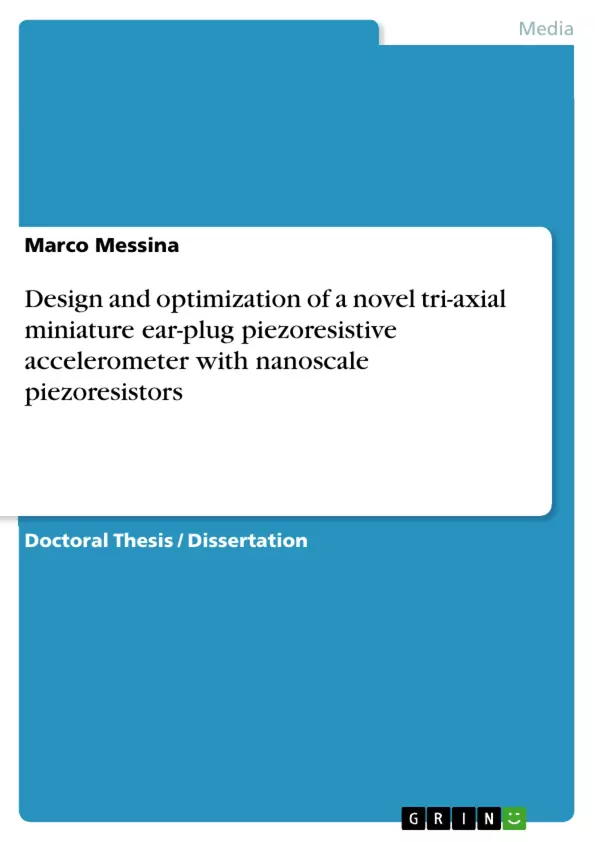This work aims at the advancement of state-of-art accelerometer design and optimization methodology by developing an ear-plug accelerometer for race car drivers based on a novel mechanical principle. The accelerometer is used for the measurements of head acceleration when an injurious event occurs. Main requirements for such sensor are miniaturization (2×2 mm), because the device must be placed into the driver earpiece, and its measurement accuracy (i.e. high sensitivity, low crosstalk and low nonlinearity) since the device is used for safety monitoring purpose.
A micro-electro-mechanical system (MEMS)-based (bulk micromachined) piezoresistive accelerometer was selected as enabling technology for the development of the sensor. The primary accelerometer elements that can be manipulated during the design stage are: the sensing element (piezoresistors), the micromechanical structure and the measurements circuit. Each of these elements has been specifically designed in order to maximize the sensor performance and to achieve the miniaturization required for the studied application.
To achieve accelerometer high sensitivity and miniaturization silicon nanowires (SiNWs) as nanometer scale piezoresistors are adopted as sensing elements. Currently this technology is at an infancy stage, but very promising through the exploitation of the “Giant piezoresistance effect” of SiNWs. This work then measures the potential of the SiNWs as nanoscale piezoresistors by calculating the major performance indexes, both electrical and mechanical, of the novel accelerometer. The results clearly demonstrate that the use of nanoscale piezoresistors boosts the sensitivity by 30 times in comparison to conventional microscale piezoresistors. A feasibility study on nanowires fabrication by both top-down and bottom-up approaches is also carried out.
The micromechanical structure used for the design of the accelerometer is an optimized highly symmetric geometry chosen for its self-cancelling property. This work, for the first time, presents an optimization process of the accelerometer micromechanical structure based on a novel mechanical principle, which simultaneously increases the sensitivity and reduces the cross-sensitivity progressively. In the open literature among highly symmetric geometries no other study has to date reported enhancement of the electrical sensitivity and reduction of the cross-talk at the same time.
Inhaltsverzeichnis (Table of Contents)
- Abstract
- Introduction
- Background
- Accelerometer design and optimization
- Piezoresistive accelerometer
- Silicon nanowires for piezoresistive accelerometer
- Accelerometer design and optimization
- Piezoresistors
- Micromechanical structure
- Measurement circuit
- Silicon nanowires based piezoresistors
- Giant piezoresistance effect of SiNWs
- SiNWs fabrication
- Accelerometer design and optimization
- Self-cancelling property of the micromechanical structure
- Optimization process
- Influence of a uniform mass moment of inertia
- Design and optimization of the measurement circuit
- Results and discussion
- Future work
Zielsetzung und Themenschwerpunkte (Objectives and Key Themes)
This PhD thesis aims to advance the state-of-the-art in accelerometer design and optimization by developing a miniature ear-plug accelerometer for race car drivers. The research focuses on achieving miniaturization, high sensitivity, low crosstalk, and low nonlinearity in the accelerometer design, ensuring its effectiveness in safety monitoring.
- Miniaturization of accelerometer design for ear-plug implementation
- Optimization of sensitivity and measurement accuracy for safety monitoring
- Utilization of silicon nanowires (SiNWs) as nanoscale piezoresistors to enhance sensitivity
- Development of a novel mechanical principle for optimizing the micromechanical structure
- Design and optimization of the measurement circuit to maximize performance
Zusammenfassung der Kapitel (Chapter Summaries)
- Abstract: This section provides an overview of the thesis's key objectives, including the development of a miniature ear-plug accelerometer using silicon nanowires as nanoscale piezoresistors. It highlights the advancements in accelerometer design and optimization achieved through the research.
- Introduction: This chapter introduces the context and motivation behind the development of the novel accelerometer, emphasizing the need for miniaturization, high sensitivity, and low crosstalk for safety monitoring applications in race car driving.
- Background: This section provides a comprehensive review of the current state-of-the-art in accelerometer design and optimization, focusing on piezoresistive accelerometers and the potential of silicon nanowires as nanoscale piezoresistors. It explores existing technologies and challenges in the field.
- Accelerometer Design and Optimization: This chapter delves into the design and optimization process of the accelerometer, covering the selection and design of piezoresistors, the micromechanical structure, and the measurement circuit. It explores the key factors influencing the accelerometer's performance.
- Silicon Nanowires Based Piezoresistors: This section focuses on the application of silicon nanowires as nanoscale piezoresistors, examining the "Giant piezoresistance effect" and exploring fabrication methods for SiNWs. It analyzes the potential of SiNWs to significantly boost the sensitivity of the accelerometer.
- Accelerometer Design and Optimization: This chapter continues the discussion on accelerometer design and optimization, concentrating on the micromechanical structure's self-cancelling property, optimization processes based on a novel mechanical principle, and the influence of a uniform mass moment of inertia on performance.
- Design and Optimization of the Measurement Circuit: This section focuses on the design and optimization of the measurement circuit, exploring its impact on the overall performance of the accelerometer.
- Results and Discussion: This chapter presents the results obtained from the research, including the sensitivity enhancements achieved by the novel accelerometer design and the reduction in cross-sensitivity. It discusses the significance of these findings and their implications for future development.
Schlüsselwörter (Keywords)
The primary focus of this thesis lies in the design and optimization of a novel tri-axial miniature ear-plug piezoresistive accelerometer utilizing nanoscale piezoresistors. Key concepts include miniaturization, high sensitivity, low crosstalk, and low nonlinearity in accelerometer design, silicon nanowires (SiNWs) as piezoresistors, "Giant piezoresistance effect," micromechanical structure optimization, and measurement circuit design for maximizing performance.
- Quote paper
- Marco Messina (Author), 2013, Design and optimization of a novel tri-axial miniature ear-plug piezoresistive accelerometer with nanoscale piezoresistors, Munich, GRIN Verlag, https://www.grin.com/document/384295



